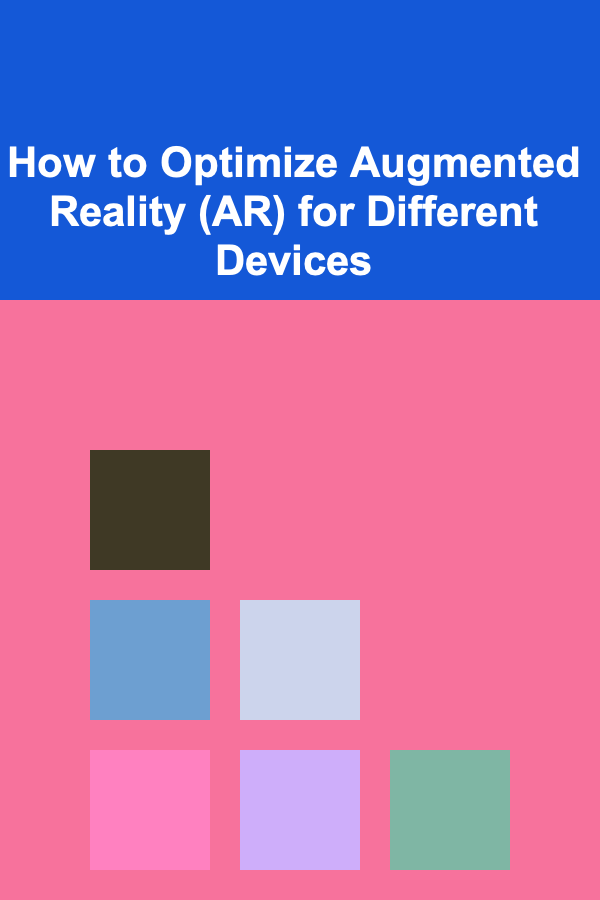
How to Optimize Augmented Reality (AR) for Different Devices
ebook include PDF & Audio bundle (Micro Guide)
$12.99$6.99
Limited Time Offer! Order within the next:

Augmented Reality (AR) is an immersive technology that overlays digital content onto the physical world. From gaming apps to industrial applications, AR has seen an exponential rise in popularity. However, optimizing AR experiences across a variety of devices remains one of the most significant challenges developers face. Different devices come with distinct hardware and software configurations, including varying processing power, screen sizes, sensors, and more. Therefore, optimizing AR for multiple devices requires a deep understanding of these differences and how to adapt the experience accordingly.
In this article, we will explore the key considerations for optimizing AR experiences across various devices, such as smartphones, tablets, smart glasses, and headsets. We will also discuss strategies for improving performance, ensuring compatibility, and providing a seamless, engaging experience for users regardless of the device they are using.
Understanding Device Differences in AR
a. Smartphones and Tablets
Smartphones and tablets are the most common devices for AR experiences, and they come with their unique set of challenges and opportunities. These devices are equipped with a range of sensors like cameras, accelerometers, gyroscopes, and GPS, which are essential for AR. However, the performance of AR can differ significantly depending on the hardware specifications, such as processor speed, RAM, and graphics capabilities.
For example, high-end smartphones with powerful processors like the Apple A15 Bionic or Snapdragon 8 Gen 2 offer smoother AR experiences, while budget devices with lower processing power may struggle to handle complex AR environments. Furthermore, screen size and resolution play an important role in how AR content is viewed. Smaller screens with lower resolution may make the AR experience less immersive.
b. Smart Glasses
Smart glasses like Microsoft HoloLens, Magic Leap, and Google Glass offer a different type of AR experience. These devices are wearable and designed for hands-free interaction with augmented content. While they offer a more immersive experience than smartphones, smart glasses come with limitations such as smaller field of view (FOV), lower processing power, and limited battery life. Additionally, these devices are often designed with a specific use case in mind, such as industrial applications or hands-free communication, and they may require specialized software for optimal performance.
c. AR Headsets
AR headsets, such as the Microsoft HoloLens 2 or the upcoming Apple AR headset, offer the most immersive AR experiences. These devices are designed specifically for AR applications and come with advanced features like spatial tracking, depth sensing, and high-resolution displays. However, AR headsets are often more expensive and have higher power consumption compared to smartphones and tablets. Additionally, they can be bulky and are often not as portable as other devices, limiting their use to specific environments like industrial settings or dedicated AR labs.
d. PCs and Laptops
Although not as common for AR as mobile devices, PCs and laptops can be used to experience AR through external accessories such as headsets or cameras. These devices typically offer more processing power, but the experience is often less immersive compared to smartphones or dedicated AR headsets. AR on PCs and laptops also often requires higher bandwidth and more advanced software to process real-time data and render AR content.
Key Factors to Consider for Optimizing AR for Different Devices
a. Processing Power
The processing power of the device is a critical factor in AR optimization. AR applications rely heavily on real-time processing of environmental data, such as camera feed, motion tracking, and object recognition. The more powerful the device's processor, the more complex the AR experiences it can handle.
- Smartphones and Tablets: For mobile AR applications, it's essential to optimize the code and minimize resource-heavy tasks. Developers can use techniques like object culling (removing unseen objects) and level of detail (LOD) to ensure that the app performs smoothly on devices with lower processing power.
- Smart Glasses and AR Headsets: These devices often feature specialized processors optimized for AR. However, even with powerful processors, AR headsets have constraints in terms of battery life and heat generation. Therefore, developers should aim to create optimized, energy-efficient applications that balance performance and power consumption.
b. Sensors and Tracking
Accurate sensor data and tracking are the backbone of AR experiences. Different devices come equipped with a range of sensors, such as accelerometers, gyroscopes, magnetometers, cameras, and depth sensors. The accuracy of these sensors varies between devices, so developers must account for these differences.
- Smartphones and Tablets: Modern smartphones typically have a suite of sensors, but their accuracy may vary. It's important to implement sensor fusion techniques, which combine data from multiple sensors to improve accuracy. Additionally, consider using AR frameworks like ARKit (for iOS) and ARCore (for Android) that provide built-in sensor calibration and tracking features.
- Smart Glasses and AR Headsets: These devices often come with more advanced sensors, including depth sensors, which allow for better environmental mapping and object interaction. The challenge here is balancing the processing power required for real-time sensor data processing with the device's performance limitations.
c. Battery Life
Battery consumption is a crucial consideration for mobile devices, especially when developing AR experiences that require constant sensor input and high graphical rendering. AR applications can be particularly taxing on battery life, especially when using advanced sensors and processing power.
- Smartphones and Tablets: Optimizing battery consumption can involve reducing the frequency of sensor updates, adjusting graphics quality, and utilizing power-saving modes when the AR experience is not actively in use.
- Smart Glasses and AR Headsets: These devices often have a limited battery life, sometimes only lasting a few hours. To optimize performance, developers should aim to create energy-efficient AR applications that balance processing power and sensor usage to minimize power drain.
d. Field of View (FOV) and Screen Size
The field of view and screen size of AR devices play a significant role in user experience. A larger FOV and higher-resolution screen create a more immersive experience, but not all devices offer the same specifications.
- Smartphones and Tablets: Mobile AR experiences are constrained by the screen size of the device. Optimizing for these devices involves creating content that works well on smaller screens without compromising the quality of the experience.
- Smart Glasses and AR Headsets: Smart glasses and headsets often have a smaller FOV, which can limit the user's ability to interact with augmented content. Optimizing the AR experience on these devices may involve creating content that can be easily interacted with in a limited space or adjusting the level of interactivity to match the device's capabilities.
e. User Interface (UI) and Interaction Design
User interface design is another critical aspect of AR optimization, particularly for devices with varying input methods.
- Smartphones and Tablets: AR on mobile devices typically uses touchscreens and gyroscope-based gestures for interaction. Optimizing the UI for mobile devices involves ensuring that the content is easily interactable via touch, swipe, and tap gestures. Additionally, since mobile screens are smaller, developers should avoid cluttered UI elements and focus on essential information.
- Smart Glasses and AR Headsets: Smart glasses and AR headsets often rely on gesture controls, voice commands, or external controllers. Designing an intuitive and easy-to-use interface for these devices requires understanding the unique input methods and ensuring that interactions are seamless. For instance, implementing hand-tracking or gaze-based controls can create a more natural experience for users.
Strategies for Optimizing AR for Different Devices
a. Use of AR Frameworks
ARKit (for iOS) and ARCore (for Android) are two of the most widely used AR development frameworks. These frameworks provide tools and APIs that help developers optimize AR experiences for different devices. They take care of much of the heavy lifting when it comes to sensor calibration, motion tracking, and environmental understanding, allowing developers to focus on building rich and interactive content.
- ARKit: For iOS developers, ARKit offers a range of optimization features, including plane detection, object tracking, and face tracking. The framework also uses hardware acceleration, which can significantly improve AR performance on supported devices.
- ARCore: ARCore provides similar features for Android devices, including environmental understanding, motion tracking, and light estimation. ARCore also allows for device-specific optimizations, such as adjusting to different screen sizes, sensor configurations, and processing capabilities.
By leveraging these frameworks, developers can ensure that their AR applications are optimized for a wide range of devices.
b. Adaptive Content Delivery
To optimize AR content across different devices, it's important to use adaptive content delivery techniques. This includes adjusting the graphical fidelity, resolution, and complexity of the AR experience based on the device's capabilities. For example, high-end devices may be able to support higher-resolution textures and more complex 3D models, while lower-end devices may require simplified content to maintain smooth performance.
c. Cloud-Based Processing
For AR applications that require significant processing power, such as complex 3D simulations or AI-based interactions, cloud-based processing can offload the heavy lifting to remote servers. This reduces the strain on the device's processing power and allows for more complex AR experiences to be delivered in real time. Cloud-based AR also helps extend the battery life of mobile devices by reducing the need for constant local processing.
d. Optimizing for Multiple Devices Simultaneously
In some cases, developers may want to create AR experiences that work seamlessly across multiple device types, such as smartphones, smart glasses, and AR headsets. To achieve this, it's important to develop a flexible AR application that can adjust to the capabilities of the device on which it is running. This may involve creating modular content that can be loaded dynamically based on the device's performance and available features.
Conclusion
Optimizing AR for different devices requires a deep understanding of the unique characteristics of each device, including its hardware, sensors, screen size, and user interaction methods. By focusing on key aspects such as processing power, sensor accuracy, battery life, and user interface design, developers can create seamless and engaging AR experiences across a wide range of devices.
As AR technology continues to evolve, the ability to optimize experiences for various devices will become even more crucial. By leveraging AR frameworks, adaptive content delivery, cloud-based processing, and a flexible approach to device compatibility, developers can ensure that their AR applications offer the best possible experience for users, regardless of the device they use.
Ultimately, the goal of AR optimization is to provide users with immersive, interactive, and efficient experiences that take full advantage of the unique capabilities of each device, while overcoming the constraints that come with them.

How to Start Financial Planning as a Freelancer
Read More
How to Tackle a Whole-House Renovation Without Overwhelm
Read More
How to Understand Push-Your-Luck Board Games
Read More
Understanding Business Ethics for Small Businesses
Read More
Developing Cross-Chain Solutions: A Comprehensive Guide
Read More
How to Develop Black and White Film at Home
Read MoreOther Products

How to Start Financial Planning as a Freelancer
Read More
How to Tackle a Whole-House Renovation Without Overwhelm
Read More
How to Understand Push-Your-Luck Board Games
Read More
Understanding Business Ethics for Small Businesses
Read More
Developing Cross-Chain Solutions: A Comprehensive Guide
Read More